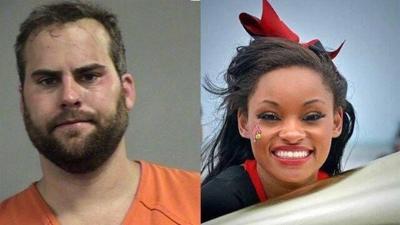LOUISVILLE, Ky. (WDRB) -- A jury found Bradley Caraway guilty Thursday of reckless homicide and driving under the influence in the crash that killed 25-year-old University of Louisville cheerleader Shanae Moorman in August 2016.
After more than four hours of deliberations, the jury returned a verdict in the trial that lasted four days and relied upon witness testimony from several medical examiners and police investigators.
But despite the conviction, Caraway walked away a free man. He was on home incarceration for six years while awaiting trial. He was also convicted on a reckless homicide charge, not murder. The low-level felony has a maximum penalty of five years behind bars, so Caraway got credit for his house arrest time served and walked free after Thursday's conviction.
"We wish that Shanae (was) here, and we know she is not," said Commonwealth's Attorney Gerina Whethers. "It's been a very, very troubling and emotional seven years for the family."
Caraway, who was 34 at the time of the crash, was under the influence when police said he crashed the vehicle that he and Moorman were riding in during the early morning hours of August 2016. Police said Moorman was the only one at the scene when officers arrived. She had been thrown from the vehicle and was pinned under it. She died as a result of her injuries.
On Tuesday, jurors heard from Medical Examiner Dr. Jeffrey Springer, who did the autopsy on Moorman, a paramedic who responded to the crash and Dr. Bill Smock, a former medical examiner with expertise in medical forensics.
Smock was a key witness for the prosecution because it was his investigation back in 2016 that found Caraway to be the driver based on evidence of windshield glass in his hair, seatbelt marks that would show he was restrained and didn't fly from the car and therefore lived, among other things.
Springer was the medical examiner who performed Moorman's autopsy. He testified that she died from traumatic asphyxia after the crash. He said he commonly sees blunt force trauma as the cause of death for many car crash victims, but that was not the case for Moorman. Instead, he said "traumatic asphyxia" means she died because she was unable to breathe after she was pinned under the car. Springer also said Moorman had broken ribs.
Springer's testimony was important, speaking to the question of whether Caraway could have pulled Moorman out to help save her.
"Asphyxia is the lack of oxygen in the body or the inability of the body to use oxygen," he said. "There are multiple causes of asphyxia: traumatic asphyxia is one of those, and that is due to the compression of the body by an object that prevents the diaphragm and the ribs from rising and therefore bringing in air, and thus no oxygen."
Caraway's defense team, led by attorney Rob Eggert, argued that Caraway was not the driver of the vehicle at the time of the crash. On Wednesday, a crash expert tried to prove that. Henry Cease, a former Kentucky State Police trooper with 20 years of experience, was called to the stand as a crash reconstruction expert.
"There is truth to be had in this case, there is science," said Eggert after the jurors returned Thursday's verdict. "There are facts, there is proof, there is DNA. The truth is to be found in the evidence."
Caraway was found hours after the crash walking along Interstate 265, shirtless and barefoot. Police said his blood-alcohol content was at least twice the legal limit.
"A person should never drive a car if their blood-alcohol level is twice the legal limit. They should not drive at 83 miles per hour, and they should not drive with an unbelted passenger," said Assistant Commonwealth's Attorney Andrew Daley. "We have proven the defendant did all of those things."
The prosecution argued that Caraway was driving drunk, wore a seatbelt, survived the crash and walked away. Cease testified that after reviewing all of the Louisville Metro Police documents and medical forensics, he believed Caraway was in the passenger seat, wasn't wearing a seatbelt and was ejected from the car first.
He believed that at the very end of the rollover crash, Moorman slipped out of the seatbelt from the driver's seat, which he claimed is possible during rollovers.
The prosecution re-called a previous witness, Lt. Clarence Beauford of LMPD, who said that wasn't true.
"We work a number of rollover collisions — and weekly they occur here in Louisville — and many, many, many times, a restrained occupant is still inside of that restraint as that rollover occurs," Beauford said.
Related Stories:
- Defense calls only 1 witness in murder trial of man charged in former UofL cheerleader's death
- Medical examiners testify in Day 4 of trial of man charged in former UofL cheerleader's death
- Jury to decide whether suspect in DUI murder case was driving in crash that killed UofL cheerleader
- Judge says 2016 murder case of former U of L cheerleader 'very unfortunately' taking long time to resolve
Copyright 2023 WDRB Media. All Rights Reserved.














